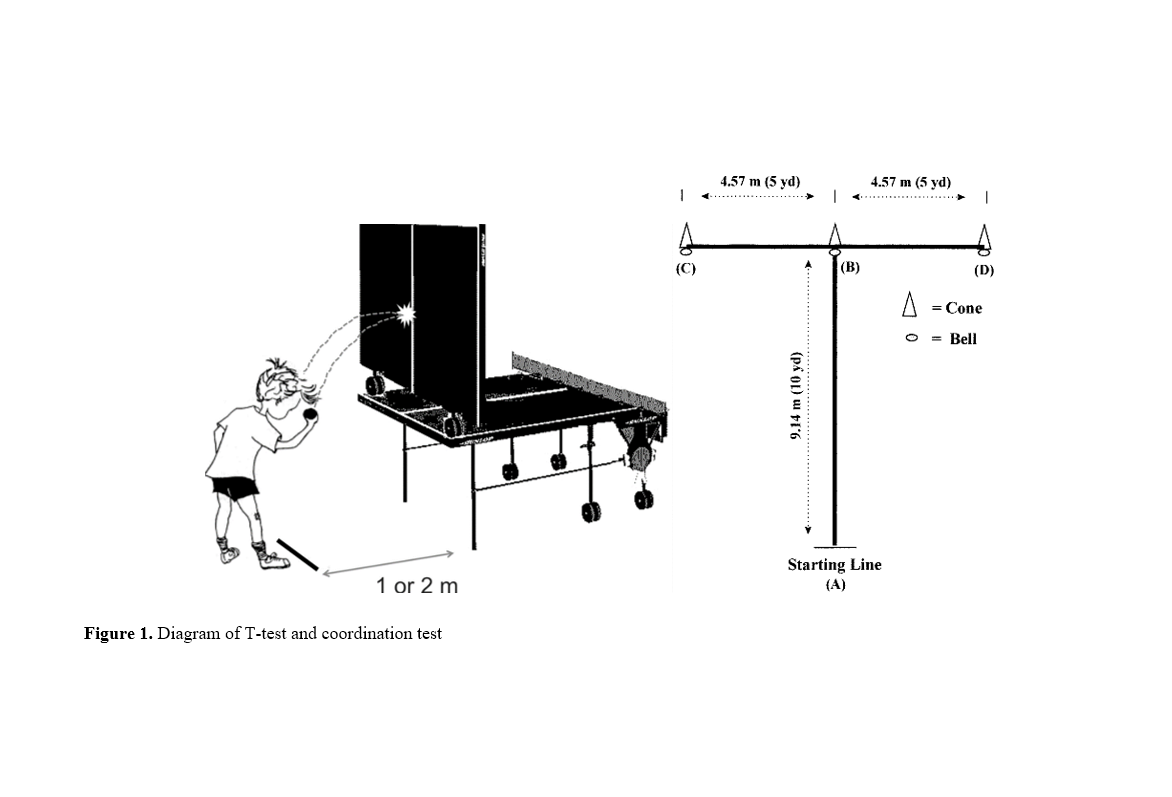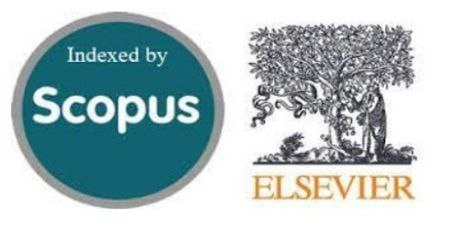Impact of Age, Gender, and Body Composition on Balance, Coordination, and Agility in Children and Adolescents
Keywords:
Gender, Age, Body composition, Balance, Coordination, AgilityAbstract
Objective: Balance and coordination are crucial for the development of motor skills and are influenced by age and gender. This study aimed to examine the effects of age and gender on balance, coordination, and agility in children and adolescents.
Methods and Materials: A total of 405 participants (211 boys and 194 girls) aged 7 to 13 years were assessed. Static balance (with eyes open and closed) was measured with the Stork Test, coordination was assessed using the Eye-hand coordination test, and agility was measured through the T-test and 4×9 test. Pearson correlation and independent t-test were used for data analysis.
Findings: The results indicated significant differences in BMI (Р=0.048) and body fat percentage (Р=0.001) in girls compared to boys at age 9, as well as in static balance with eyes closed at ages 7 (Р=0.034) and 10 (Р=0.003). Coordination was also significantly higher in boys than girls at ages 11 (Р=0.000) and 12 (Р=0.000). Furthermore, body fat percentage was found to have a stronger effect on balance and motor function in boys than in girls.
Conclusion: Based on these findings, maintaining a healthy body fat percentage is recommended for both genders to support better health and physical performance.
Downloads
References
1. Dencker M, Andersen LB. Health‐related aspects of objectively measured daily physical activity in children. Clinical physiology and functional imaging. 2008;28(3):133-44. [PMID: 18241209] [DOI]
2. Ortega FB, Ruiz JR, Castillo MJ, Sjöström M. Physical fitness in childhood and adolescence: a powerful marker of he alth. International journal of obesity. 2008;32(1):1-11. [PMID: 18043605] [DOI]
3. Lu AK-M, Tsai S-Y, Lin C-Y, Hsieh J-L. Discriminating factors of body composition characteristics for academi c performance in nursing college students: a cross-sectional study. BMC nursing. 2024;23(1):305. [PMID: 38702723] [PMCID: PMC11069266] [DOI]
4. Kim S, Won CW. Sex-different changes of body composition in aging: a systemic review. Archives of gerontology and geriatrics. 2022;102:104711. [PMID: 35588612] [DOI]
5. Bala G. Metodologija kineziometrijskih istraživanja: sa posebnim osvrtom na mo torička merenja: Fakultet sporta i fizičkog vaspitanja; 2010 2010.
6. Iseni A, Ademi B, Ademi A. Relationship and influence of body composition and some skin folds on speed and agility performance. International Journal of Sport Sciences and Health. 2022;9(17-18):33-9.
7. Nićin Đ. Antropomotorika-teorija [Anthropomotorics-Theory]. Serbian Novi Sad: Faculty of Sport and Physical Education. 2000.
8. Nashner LM. Practical biomechanics and physiology of balance. Balance function assessment and management. 2014;431.
9. Shumway-Cook A, Woollacott MH. Dynamics of postural control in the child with Down syndrome. Physical therapy. 1985;65(9):1315-22. [PMID: 3162178] [DOI]
10. King-Dowling S, Proudfoot NA, Cairney J, Timmons BW. Motor Competence, Physical Activity, and Fitness across Early Childhoo d. Medicine and science in sports and exercise. 2020;52(11):2342-8. [PMID: 32366800] [DOI]
11. Mickle KJ, Munro BJ, Steele JR. Gender and age affect balance performance in primary school-aged child ren. Journal of science and medicine in sport. 2011;14(3):243-8. [PMID: 21276751] [DOI]
12. Holm I, Fredriksen PM, Fosdahl M, Vøllestad N. A normative sample of isotonic and isokinetic muscle strength measurem ents in children 7 to 12 years of age. Acta Paediatrica. 2008;97(5):602-7. [PMID: 18355391] [DOI]
13. Liu R, Yang J, Xi F, Xu Z. Relationship between static and dynamic balance in 4-to-5-year-old pre schoolers: a cross-sectional study. BMC pediatrics. 2024;24(1):295. [PMID: 38724964] [PMCID: PMC11080223] [DOI]
14. Conner BC, Petersen DA, Pigman J, Tracy JB, Johnson CL, Manal K, et al. The cross-sectional relationships between age, standing static balance , and standing dynamic balance reactions in typically developing child ren. Gait & posture. 2019;73:20-5. [PMID: 31299500] [PMCID: PMC6707867] [DOI]
15. Marchesi G, Luca A, Squeri V, Michieli L, Vallone F, Pilotto A, et al. A lifespan approach to balance in static and dynamic conditions: the e ffect of age on balance abilities. Frontiers in Neurology. 2022;13:801142. [PMID: 35265025] [PMCID: PMC8899125] [DOI]
16. Poveda NE, Adair LS, Martorell R, Patel SA, Ramirez‐Zea M, Stein AD. Early life predictors of body composition trajectories from adolescenc e to mid‐adulthood. American Journal of Human Biology. 2023;35(11):e23952. [PMID: 37401888] [PMCID: PMC10764641] [DOI]
17. Rusek W, Adamczyk M, Baran J, Leszczak J, Inglot G, Baran R, et al. Is There a Link between Balance and Body Mass Composition in Children and Adolescents? International journal of environmental research and public health. 2021;18(19):10449. [PMID: 34639749] [PMCID: PMC8507937] [DOI]
18. González-Devesa D, López-Eguía A, Amoedo L, Ayán-Pérez C. Associations between Agility, the Relative Age Effect, Siblings, and D igit Ratio (D2: D4) in Children and Adolescents. Children. 2024;11(8):893. [PMID: 39201828] [PMCID: PMC11353056] [DOI]
19. Boutios S, Fiorilli G, Buonsenso A, Daniilidis P, Centorbi M, Intrieri M, et al. The impact of age, gender and technical experience on three motor coor dination skills in children practicing taekwondo. International journal of environmental research and public health. 2021;18(11):5998.
20. Pletcher ER, Dekker TJ, Lephart SM, Sell TC. Sex and age comparisons in neuromuscular and biomechanical characteris tics of the knee in young athletes. International Journal of Sports Physical Therapy. 2021;16(2):438. [PMID: 33842039] [PMCID: PMC8016419] [DOI]
21. Sturnieks DL, Menant J, Lord SR. Balance and ageing. The Biology of Ageing: CRC Press; 2022. p. 223-34[DOI]
22. Vispute S, Mandlik R, Khadilkar A, Gondhalekar K, Patwardhan V, Khadilkar V. Influence of ecoregional and lifestyle factors on growth and body comp osition of I ndian children and adolescents aged 9–18 years—A multicen ter study. American Journal of Human Biology. 2023;35(4):e23850. [PMID: 36541922] [DOI]
23. Li R, Liu M, Zhu J, Li R, Zhao H, Zhang L. Age and gender differences in static and dynamic balance of Chinese pr eschool children. Frontiers in physiology. 2022;13:1013171. [PMID: 36324303] [PMCID: PMC9618940] [DOI]
24. Sisson M, Harvey BS, Stork NC. Physical maturation. The Youth Athlete: Elsevier; 2023. p. 5-11[DOI]
25. Shi P, Feng X. Motor skills and cognitive benefits in children and adolescents: Relat ionship, mechanism and perspectives. Frontiers in Psychology. 2022;13:1017825. [PMID: 36478944] [PMCID: PMC9721199] [DOI]

Downloads
Additional Files
Published
Issue
Section
License
Copyright (c) 2025 Mohsen Ebrahimi (Corresponding Author); Mehdi Changizi (Author)

This work is licensed under a Creative Commons Attribution-NonCommercial 4.0 International License.







